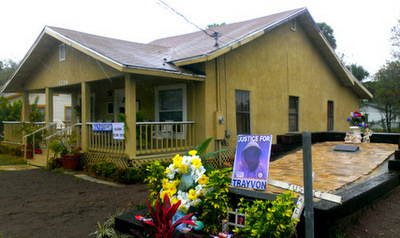|
A Year After Trayvon Martin, Sanford Reflects on Case's Legacy  March 01, 2013 | WMFE - One year ago in Sanford, unarmed black 17-year-old Trayvon Martin was shot dead by a white Hispanic neighborhood watch volunteer. Confessed shooter George Zimmerman claimed he acted in self defense and police at first declined to make an arrest, touching off a nationwide firestorm of demonstrations and debates with Central Florida at the epicenter. Today, Sanford residents differ over the changes in their community a year after the tragic incident. [Image: On February 26th, 2013, the one-year anniversary of Trayvon Martin's death, rain postpones work on the nearly completed permanent memorial in his honor outside the Goldsboro Welcome Center] At the area’s biggest rallies last year, one held in downtown Sanford and the other in the historically black community of Goldsboro, protesters called for Zimmerman’s arrest and the police chief’s job. The circumstances of the case set social media ablaze with topics from race relations to gun control, and caught the attention of national civil rights leaders. Francis Oliver, Goldsboro’s Welcome Center Director and curator of its museum across the street, says the demonstrations led by the NAACP and Reverend Al Sharpton marked the beginning of a turning point, not only in the Trayvon Martin case but also in a much older struggle. “We welcomed the pressure being put, because, see, we've been putting pressure on the Sanford Police Department for years and had got nothing done," explains Oliver. "And if something had been done, that night would've never happened.” Sanford Police Chief Bill Lee was eventually fired. Oliver says there’s still a long way to go to rebuild trust with the police, though. After all, many people feel that underlying tensions reach back more than 100 years. Goldsboro was Florida's second black incorporated town until Sanford unilaterally dissolved its charter and annexed it in 1911. But, Oliver observes, in just the last month, some city leaders have taken steps to improve relations between law enforcement and citizens who feel they’ve been underserved. Those efforts stem from a series of sometimes contentious meetings between Sanford officials, community members, and cops. The meetings began in the wake of Trayvon Martin's shooting. Sanford’s new Police Chief, Cecil Smith, starts in April. Oliver says he has a tough job waiting for him. “When he comes, he can’t step too high, he can't sidestep and he can't backstep - he's got to step forward, and step right.” Other residents have different perspectives on the past year. In downtown Sanford, 2012's other major rally site, local musician Nick Cardinale is passing by. He says things haven’t changed much for him. “I've been seeing a lot more police cars and stuff cruising, but other than that, as far as the case or anything, no," says Cardinale. "Everything seems to be business as usual.” But at The Corner Café, owner Chef Michael O’Brien says he thinks things are better now than they were because Trayvon Martin's case went to the justice system instead of being "swept under the rug." Zimmerman was arrested about six weeks after the February 26th incident. Zimmerman called police that night to report Trayvon as suspicious as the teen walked back to his father's house after buying snacks at a nearby store, then followed him for a time. The exact details of the altercation between the two are still unclear. O’Brien says, in his experience, the Sanford police do try to reach out and be part of the community. “I think they've always done that. As a business owner, I've been to countless meeting where [they say], ‘We want to hear what your concerns are, what your needs are,’ and they respond.” And, he points out, he doesn’t think what happened between Trayvon Martin and George Zimmerman was about race. “It looks like we had someone overstep their authority – that would be George Zimmerman,” O’Brien says. “It looks like we had someone who comes from an area, Miami – Trayvon – where things are much less neighborly, and I think when those two things came together you had worlds colliding and it came to a bad result.” Nor is race the main concern for Goldsboro museum volunteer Nikki Clayton. She says the shooting boils down to a tragic situation that could have happened to anyone’s child. “We need to get justice for that child that was killed," says Clayton. "Instead of bombarding everything with race, wipe that out and just think about that kid’s death. That’s just my perspective on it.” Clayton says she's seen a little change in the past year, but she was hoping to see her community come together for that common cause of justice for a child. She says that's taking a bit longer than she thought it would. “I’ve seen the divide of going to the commissioner’s meeting, and you have whites sitting on one side and blacks sitting on the other side,” Clayton says. “We don’t need to go back in those times. This is the time now, everybody needs to start banding together.” Banding together has been the theme of several events honoring Trayvon Martin recently, one a downtown Sanford candlelight vigil a few hundred strong on the anniversary of Trayvon Martin’s death, another an event held on his birthday earlier this month by the Goldsboro Historical Association, the Sanford Police Department, and the NAACP. Francis Oliver, who helped organize both events, says there are clear signs that Sanford’s concerned black citizens are not alone. “We know now, as an African-American community, we’re not just by ourselves," she says. "Our voices are finally being heard.” George Zimmerman’s second degree murder trial is scheduled to begin June 10th. |
|
|